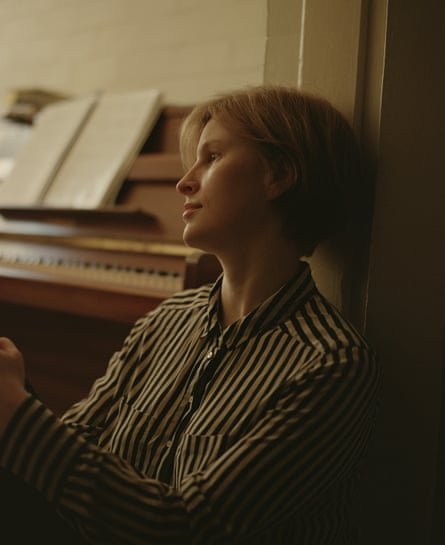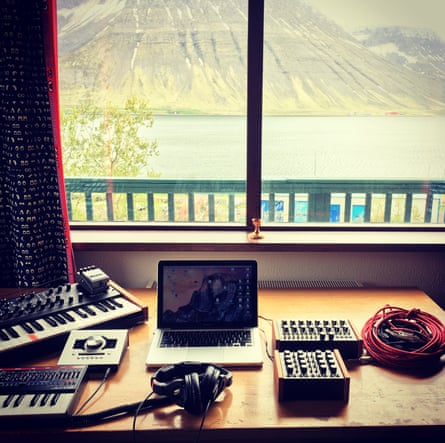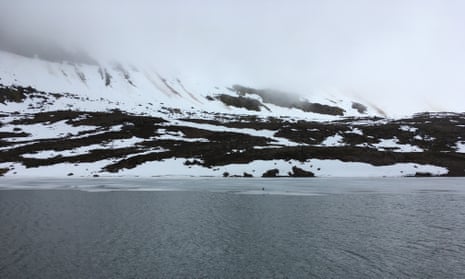At the beginning of 2016 Heather Shannon of the Jezabels felt as though “someone had pumped cement into [my] veins”. Her ovarian cancer – diagnosed in 2013 while the Jezabels recorded their second album, The Brink – had returned just as the band’s third album, Synthia, was due to be released. Her chemotherapy treatment scuttled their six-month international tour.
“It was basically the worst day of all of our lives when we couldn’t do that tour,” says Shannon, from her home studio in Coogee, Sydney. But the break from the Jezabels gave the classically trained pianist time to reconnect with her instrument and took her from bed-ridden “cabin fever” to Iceland’s fjords.
The result is Midnight Sun: a jagged, aching and transportive album of solo piano compositions, begun during a 2017 ArtIceland residency in the town of Ísafjörður. It’s an album of contrasts and contradictions: peacefulness punctuated by dissonance, swinging between “resolution and uncertainty”.

“I don’t think it ever got completely dark,” says Shannon of the far-northern hemisphere summer. “If it did, it was only for an hour or something. The birds don’t even stop. It’s really odd … it’s nighttime, the sun’s out, but it’s so quiet … I think that strangeness definitely seeped into the music.”
The album was scored with a computer, a couple of small keyboards and synthesisers, and Shannon meticulously transcribed it into sheet music upon her return to Australia.
But some passages proved technically impossible to play live. Wanting a back-to-basics approach, after years of studio tinkering with the Jezabels, Shannon restructured the compositions, recording them unadulterated on a Fazioli concert grand piano in Sydney Conservatory of Music’s Verbrugghen Hall, where she is studying a master’s in composition. On the title track you can hear the instrument’s famed brightness and clarity ring out from its soundboard, constructed from red spruce felled in the same alpine Italian forests Stradivarius once collected wood for his violins.
Midnight Sun feels out of time, written on computers but brought to life by a centuries-old musical tradition and human touch – a collision of punk and perfection that Shannon says manifests on the track Fossavatn, which has the instability of pebbles clinking down a cliff before a landslide.
“I’ve spoken to a lot of musicians that have classical training, and then give it up and do something else, and they just can’t bear to look at their instrument … because there’s all this guilt associated with it,” Shannon says. “You’re supposed to do a certain amount of hours a day, and you’re always striving for this idea of perfection in your creative practice. For me, I had to try and throw that out the window with the band.
“So I kind of wanted to bring that to my classical piano playing. For me, that was like reclaiming it … in an honest way that I felt connected to.”

For a month in Iceland Shannon bunkered down at Engi, a small yellow house overlooking Naustahvilft, a depression in the flat-topped mountains surrounding the town’s fjord. Known as “the troll seat” in Icelandic mythology, Naustahvilft is said to have been created by a weary troll relieving her aching feet in the fjord – a fitting location for Shannon’s own recuperation and creative rejuvenation. She lived with a US graphic designer and an Icelandic poet, the latter of whom had limited English but would take Shannon out to forage for rhubarb and visit relatives in a nearby cemetery.
Although Iceland is rich with inspiring myths and staggering natural beauty, Shannon is at pains to clarify that Midnight Sun is not an attempt to translate those things into sound; that she could never adequately represent the significance of Iceland’s landscape to its culture and spirituality. Rather, it’s a reflection of her experience as a foreigner awed by the landscape’s majesty – and bumbling through it while being dive bombed by nesting arctic swifts on hiking trails she suspects locals might have avoided.
“It’s such a big question in Australia, because we’re all on stolen land,” she says. “I’m from a colonising culture. Is it problematic that I represent this place? Does it matter what kind of musical language I use? If I’m using a classical music language from this European tradition, is it just furthering this kind of colonial progress?”
Shannon discovered a new side of herself in isolation. She remembers a strenuous hike to a hydroelectric dam and lake in the mountains. Looking out over the vast landscape and rolling clouds, she found herself alone. There were no fans and roadies, no bandmates to contend with, no doctors and nurses, no lovingly fussing family members.
“It was so quiet, silent. That total feeling of just being completely alone that I don’t think I’d ever experienced before. I was sort of surprised that I actually liked that feeling. I felt like I needed it.”

Comments (…)
Sign in or create your Guardian account to join the discussion